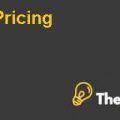The exhibit 2 in the appendices shows the total fixed costs that are equal to 100,000 Dirham. Based on the assumptions, the direct cost, labor cost and commission cost per unit has been computed that gives us a contribution per unit of 4.95 dirham. Using this information, the breakeven revenue is 20191 dirhams and the breakeven price is 4 dirhams as shown in exhibit 2 in the appendices.
Breakeven Analysis
Next, we have performed the breakeven analysis as shown in exhibit 3 in the appendices. The breakeven sales units are 20191 approximately. The detailed computations are shown in exhibit 3 in the appendices. The breakeven point is the point at which the mobile application would not be making a profit or loss. The chart for the breakeven point is shown below:
Forecasting of Financial Statements
Next, we have used the detailed financial assumptions and the revenue model to generate the forecasted income statement and the forecasted balance sheet for the Educateone social media mobile application. These are shown in exhibit 4 and 5 in the appendices. The total revenue for the social media mobile app seems to be fluctuating but overall it is growing and the profitability of the company has also increased over the 12-month period.
Educateone Social Media App Report Harvard Case Solution & Analysis
Similarly, we have generated the forecasted balance sheet for the social medial mobile application for the 12-month period. The total assets of the company seem to be increasing over the 12-month period and the other liabilities are also increasing. More analysis of the financial statements hasbeen discussed in the next section of the report that is ratio analysis.
Bottom up Sales Estimation and Estimated Costs of Service
The bottom up sales estimation is the schedule of the conversion rate of the visitors of the social media app at regular intervals such as every 3 months. On the other hand, the estimated cost of service in table 2 highlights the purchase cost for each subscriber for the application and also highlights the annual cost of subscribing for the app and the additional content. These are shown below:
| Table 1 | |||
| Bottom-Up Sales Estimations. | |||
| Period | Average Sales Cycle | Number of Visits | Conversion Rate |
| 3 months | N/A | N/A | 0% |
| 6 months | 21 day | 4122 | 60% |
| 9 months | 14 days | 4165 | 50% |
| 12 months | 7 days | 4208 | 40% |
| Table 2. | |||
| Estimated Costs of Service. | |||
| Transaction | Purchase Cost | Annual Subscription | |
| Initial Registration (both students and academic staff) | Free | N/A | |
| Post-trial use (for students) | 50 | 1000 | |
| - | - | - | |
| Additional Content | 15 | 300 | |
The conversion rate in table 1 is the number of subscribers that would be the actual active users of the app after accounting for the monthly deinstalls of 10%. The number of visits increases with the passage of time as the awareness of the application increases among the students.
Conclusion (Performance of Educateone)
The ratio analysis has been performed based on the projected financial statements of Educateone and these are shown in exhibit 6 in the appendices. The liquidity position of the mobile application seems to be.........................
This is just a sample partial work. Please place the order on the website to get your own originally done case solution









